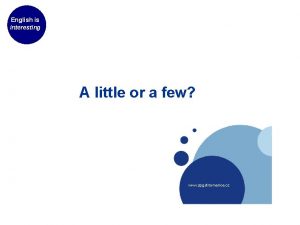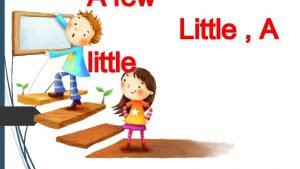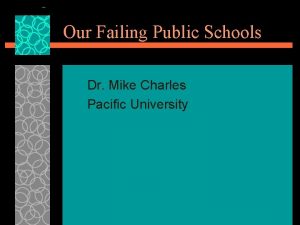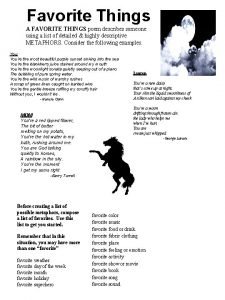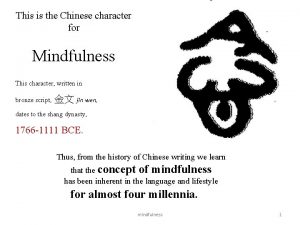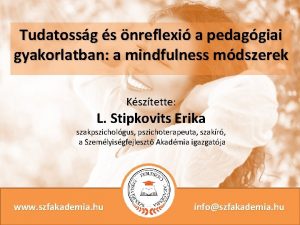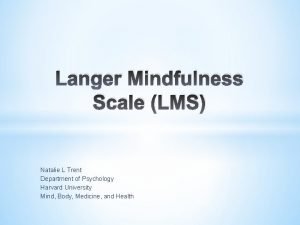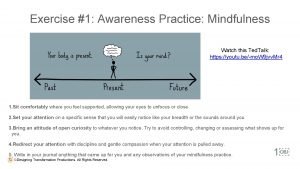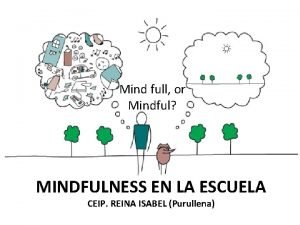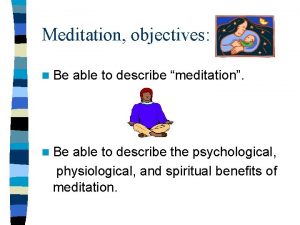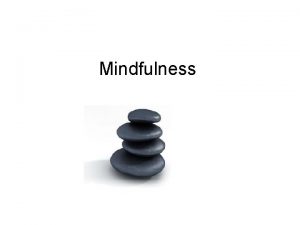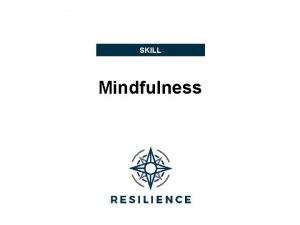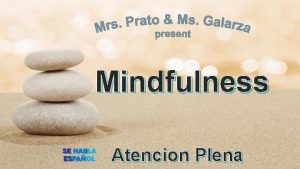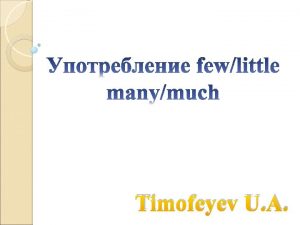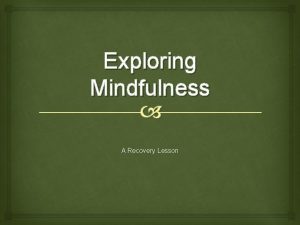Mindfulness Enough These few words are enough if

















- Slides: 17

Mindfulness Enough These few words are enough, if not these words, this breath. . . If not this breath, this sitting This opening to the life we have refused again and again until now. Until now. In this moment of epiphany This opening to the life we have refused again and again until NOW ~david whyte

Aims For participants to have sound understanding of theory and practice of mindfulness and related theory (Behavioural therapy, ACT, RFT) Provide several opportunities for participants to experience mindfulness Allow participants to begin exploration of how they may begin to use mindfulness personally or with their students/staff

Mindfulness activity Coming into this space, aware, open, experiencing

What is mindfulness Mindfulness has been described as "paying attention with openness, curiosity and flexibility" (Russ Harris, ACT) "It is the thought to involve the cultivation of concentration, attention, and non-judging acceptance toward whatever one is experiencing at the present moment" (Bishop et al, 2004

What is meditation and how do the two differ? In meditation the mind is clear, relaxed and inwardly focused. (Not always in mindfulness) When you meditate you are fully awake, alert, but your mind is not focused on the external world or the events taking place around you. (We can be mindful of the external world) Meditation requires an inner state that is still and one-pointed so that the mind becomes silent When the mind is silent and no longer distracts you, meditation deepens.

Internal Vs External Awarness Mindfulness of self and environment one is in

What does the research say? The ACBS community is well aware of the need for rigorous research. The following are a few examples: At the University of California (Department of Psychiatry and Biobehavioural Science) it was found that 15 mins of focused breathing (as apposed to the same time of either letting their minds wander or focus on the worry they have over 6 domains) allowed undergraduates to reduce the negative responses to aversive picture slides and increased willingness to remain in contact with them. (Arch & Craske, 2006) At the Rey Juan Carlos University (Spain) ACT (incorporating mindfulness) and SOC strategies were taught to elderly people in a nursing home suffering chronic pain. After the treatment the belief that medication is the main possible treatment for pain in the intervention group decreased significantly and the satisfaction with the achievement of life goals was significantly higher. (Alonso, Lopez, Losada and Gonsalez, 2013). A group at the University of Amsterdam (Department of Psychology) completed a meta-analysis of 39 randomised controlled trials on the efficacy of ACT, including 1, 821 patients with MH disorders or somatic health problems. It was found that ACT outperformed 'treatment as usual' and placebo and that ACT may be effective in treating anxiety disorders, depression, addiction, and somatic health problems as established psychological interventions. (Tjak, Davis, Morina, Powers, Smits & Emmelkamp, 2015, Psychotherapy and Psychosomatics).

So how does it work? Mindfulness and the brain.

Stay calm now. . Here comes theory! Ever done Psych 1010? If so you would have heard of the work of BF Skinner who propelled Behaviorism into the spotlight in the 60's-70's. The ABC of behaviour is a great model for explaining how people and animals get things done. For example, a child see's lollies at the supermarket (antecedent), screams "I want a lolly" (behaviour) and mum buys it (consequence). The kid has just trained mum to supply sweets on demand. Skinner however, struggled to explain language and how humans interact with each other at such a complex level. Hayes and Holmes set out to find the answers to Skinners unanswered questions. Humans learn how to derive relationships that aren't explicitly obvious and those derived relationships are applied systematically to verbal behaviour.

Ok so we learn relationships in language quite quickly. . Whys is this a problem?

When life gives you lemons

Mindfulness of. . . Emotions

Then came ACT Then along came Acceptance and Commitment Therapy or ACT as we call it, created in 1986 by Steve Hayes. Psychological flexibility relies on us 'opening up', 'being present' and 'doing what matters'. In other words we need to acknowledge our thoughts and feelings instead of avoiding them, defuse from thoughts or emotions that are holding us back (cognitive fusion & experiential avoidance) and commit to living a life true to our values. Mindfulness is the key here. It allows us to become aware of what we are doing (avoidance) and take steps towards living a meaningful life. It provides the space between what 'I think I am' (concept) and 'what I want to do' (context).

So is mindfulness the only strategy used in ACT? • No, there are many strategies used in ACT, including behavioural therapy (adjusting the antecedent and the consequences to in turn adjust the behaviour), metaphors, brainstorming, values work and so on. Nor should mindfulness be used as an isolated strategy without a link to values in some way.

So how do I know what my values are? Mindfulness of values

What if I wanted to try a few mindfulness activities with my students? would recommend some further training in the area. Preferably that with an ACT/RFT/Behavioural underlying theory/philosophy rather than a meditation/Buddhist. However, if you would like to trial a few short 'mindful' activities just to bring their focus back into what you are doing rather than still out in the playground you could try some of the following breath hand feather leaf sounds bubbles water standing walking eating drawing smelling and so on. . . Pretty much any activity could become a mindful one if you bring your full awareness to it in an open and flexible way. With children it's best if it's practical (they tend to much more pragmatic than adults) and visual. Note that 'mindful colouring' (as is the current trend) is only mindful when you are engaged with it as a form of mindfulness rather than a choice of experiential avoidance; -)

Is there time to try one more mindfulness? Mindfulness of eating
 Use of few a few the few
Use of few a few the few Insidan region jh
Insidan region jh Use these words to complete the sentences
Use these words to complete the sentences A few vai few
A few vai few Few a few little a little exercise
Few a few little a little exercise Our failing schools enough is enough
Our failing schools enough is enough Muchmany
Muchmany Im good enough i'm smart enough and doggone it
Im good enough i'm smart enough and doggone it Our failing schools enough is enough summary
Our failing schools enough is enough summary My favorite things poem
My favorite things poem Mindfulness chinese symbol
Mindfulness chinese symbol Brainpop mindfulness quiz answers
Brainpop mindfulness quiz answers Mindfulness gyerekeknek
Mindfulness gyerekeknek Langer mindfulness scale
Langer mindfulness scale Ted talk mindfulness
Ted talk mindfulness Mindfulness or mind full
Mindfulness or mind full Meditation objectives
Meditation objectives Else bisseling
Else bisseling
